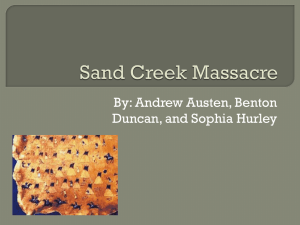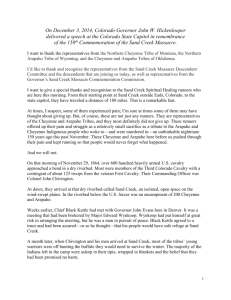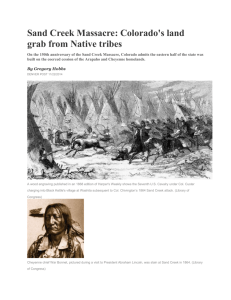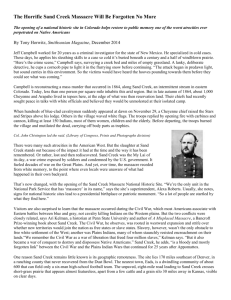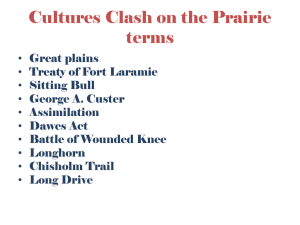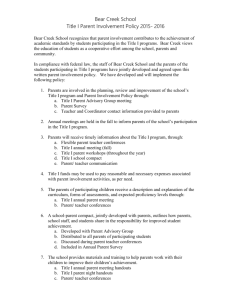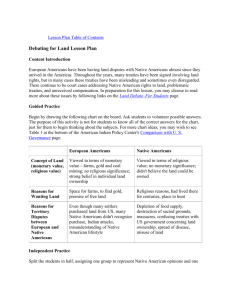General Conference of the United Methodist Church
advertisement
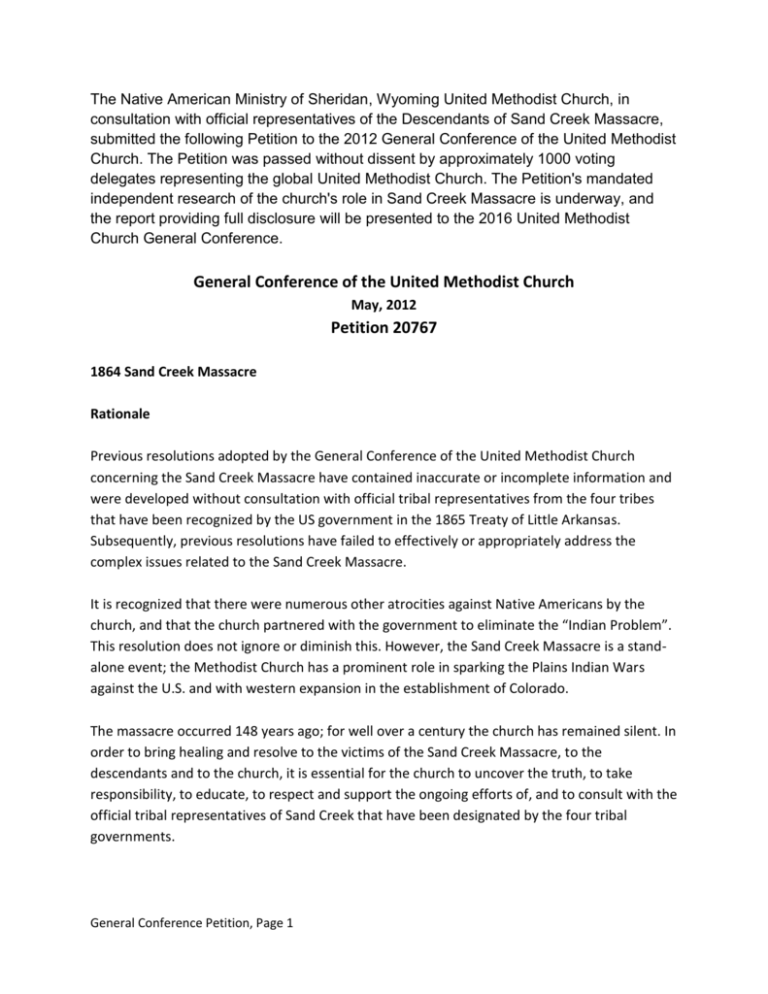
The Native American Ministry of Sheridan, Wyoming United Methodist Church, in consultation with official representatives of the Descendants of Sand Creek Massacre, submitted the following Petition to the 2012 General Conference of the United Methodist Church. The Petition was passed without dissent by approximately 1000 voting delegates representing the global United Methodist Church. The Petition's mandated independent research of the church's role in Sand Creek Massacre is underway, and the report providing full disclosure will be presented to the 2016 United Methodist Church General Conference. General Conference of the United Methodist Church May, 2012 Petition 20767 1864 Sand Creek Massacre Rationale Previous resolutions adopted by the General Conference of the United Methodist Church concerning the Sand Creek Massacre have contained inaccurate or incomplete information and were developed without consultation with official tribal representatives from the four tribes that have been recognized by the US government in the 1865 Treaty of Little Arkansas. Subsequently, previous resolutions have failed to effectively or appropriately address the complex issues related to the Sand Creek Massacre. It is recognized that there were numerous other atrocities against Native Americans by the church, and that the church partnered with the government to eliminate the “Indian Problem”. This resolution does not ignore or diminish this. However, the Sand Creek Massacre is a standalone event; the Methodist Church has a prominent role in sparking the Plains Indian Wars against the U.S. and with western expansion in the establishment of Colorado. The massacre occurred 148 years ago; for well over a century the church has remained silent. In order to bring healing and resolve to the victims of the Sand Creek Massacre, to the descendants and to the church, it is essential for the church to uncover the truth, to take responsibility, to educate, to respect and support the ongoing efforts of, and to consult with the official tribal representatives of Sand Creek that have been designated by the four tribal governments. General Conference Petition, Page 1 Whereas; the United Methodist Church, as stated in its Constitution and Social Principles, upholds respect for all creation, values all persons as individuals of sacred worth, and calls us to honor the sacredness of all that God has made, and Whereas; General Conference is the governing body of The United Methodist Church and is the proper authority to speak for the general church, and Whereas; General Conference of The United Methodist Church has adopted numerous resolutions pertaining the church’s relationship with Native Americans including: 3323 Healing of Relationships with Indigenous Persons establishing an ongoing study, dialogue and consultation with indigenous persons in all conferences; and Whereas; the 1996 General Conference adopted the resolution to Support Restitution to the Cheyenne and Arapaho Tribes of Oklahoma for the Sand Creek Massacre and a resolution The Sand Creek Apology, and Whereas; the 2008 General Conference adopted Resolution 08158 Sand Creek Massacre National Historic Site Support contributing $50,000 toward the development of the Sand Creek Massacre National Historic Site Research and Learning Center, and Whereas; the United Methodist Church acknowledges that the acts by Methodist minister, Colonel John M. Chivington, and the U.S. Military attack on the Cheyenne and Arapaho people on November 29, 1864 known as the Sand Creek Massacre, were acts against humanity, and Whereas; the Cheyenne Tribe know the 1864 pre-dawn operations by U.S. Military led by Methodist Minister Col. John Chivington to be a deliberate act of genocide that killed twelve of thirteen Cheyenne Chiefs and nearly 200 other men, woman, children and elderly, and Whereas; the Cheyenne Tribal Traditional Government consisting of the Chiefs Council of 44 to-date has never recovered from the 1864 attack, or re-established its authority as the prominent governing body due to constant U.S. military attacks lasting over a decade, the Cheyenne Tribe was forced to current geographic locations mainly in the North and the South, and Whereas; the 1864 Sand Creek Massacre outraged most plains Indian Tribes at the attempted annihilation of the Cheyenne Tribe, igniting the plains Indian wars spanning over a decade and resulting in numerous attacks and massacres similar to Sand Creek Massacre, killing not only men but also women and children, and General Conference Petition, Page 2 Whereas; the U.S. Government has not fulfilled promises made to the Cheyenne and Arapahoe Tribes through the 1865 Treaty of Little Arkansas, and Whereas; the Northern Cheyenne Tribe of Montana, the Cheyenne and Arapaho Tribes of Oklahoma, and the Northern Arapaho Tribe of Wyoming (herein referred to as: “Tribes”) are the federally recognized Tribes to the 1865 Treaty of Little Arkansas with U.S. Government, and Whereas; the “Tribes” and official Tribal Representatives along with other Federal, State, and County officials are currently implementing Sand Creek Massacre National Historic Site Act P.L. 106-243, and Whereas; the “Tribes” have on-going efforts towards preservation, repatriations, healing, awareness, research and education associated with the 1864 Sand Creek Massacre, and Whereas; the “Tribes” have an annual Sand Creek Massacre Spiritual Healing Run, a public event, to provide a sense of resolve for descendants, participants, and honor victims of the Sand Creek Massacre, and Whereas; the “Tribes” are promoting the Learning Center, in Eads, CO for educational and research purposes associated with the Sand Creek Massacre, which Learning Center has received a United Methodist Church donation of $50,000, and Whereas; at this time there is no full and clear understanding of the involvement and influence in the Sand Creek Massacre of John M. Chivington, Territorial Governor John Evans, the Methodist Church as an institution, and other prominent social, political and religious leaders of the time, and Therefore, be it resolved: Petition 20767 The 2012 General Conference of the United Methodist Church hereby fully recognizes the Northern Cheyenne Tribe of Montana, and the Cheyenne and Arapaho Tribes of Oklahoma, and the Northern Arapaho of Wyoming as the Federally recognized Tribes as stated in the 1865 Treaty of Little Arkansas with U.S. Government, as the official representatives concerning the Sand Creek Massacre. The 2012 General Conference of the United Methodist Church through the Council of Bishops and the appropriate boards and agencies shall consult on and support efforts pertaining to General Conference Petition, Page 3 preservation, repatriations, healing, awareness, research, education and reparations with the Northern Cheyenne Tribe of Montana, Cheyenne and Arapaho Tribes of Oklahoma, and the Northern Arapaho Tribe of Wyoming and their official Tribal Representatives for the November 29, 1864 Sand Creek Massacre. The 2012 General Conference of the United Methodist Church through the Council of Bishops and the General Commission on Archives and History shall authorize research by a joint team including an independent body and provide full disclosure of the involvement and influence in the Sand Creek Massacre of John M. Chivington, Territorial Governor John Evans, the Methodist Church as an institution, and other prominent social, political and religious leaders of the time, and shall report back to the 2016 General Conference. The United Methodist Church shall support and participate in the return to the “Tribes” of any Native artifacts or remains related to the Sand Creek Massacre. General Conference Petition, Page 4
